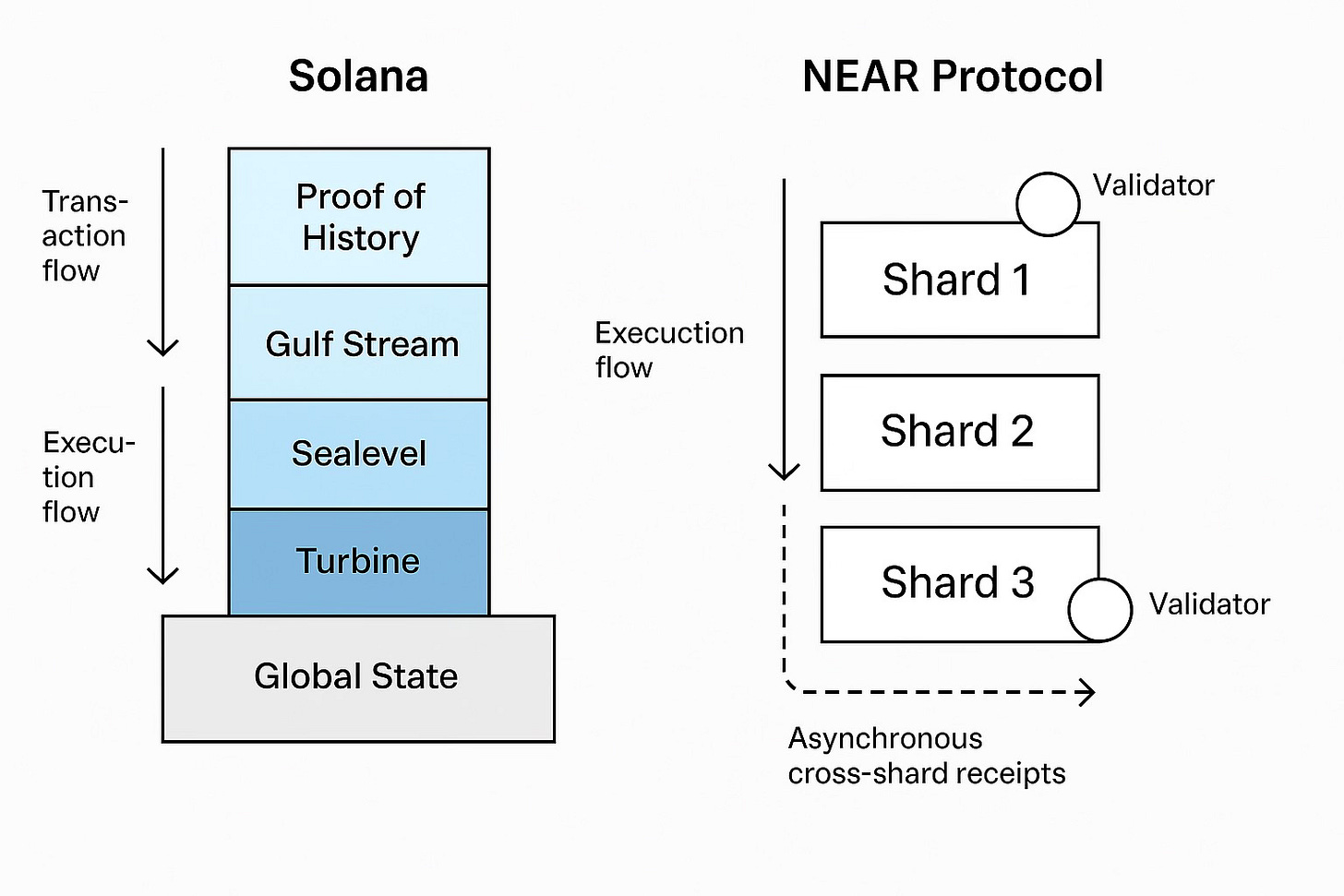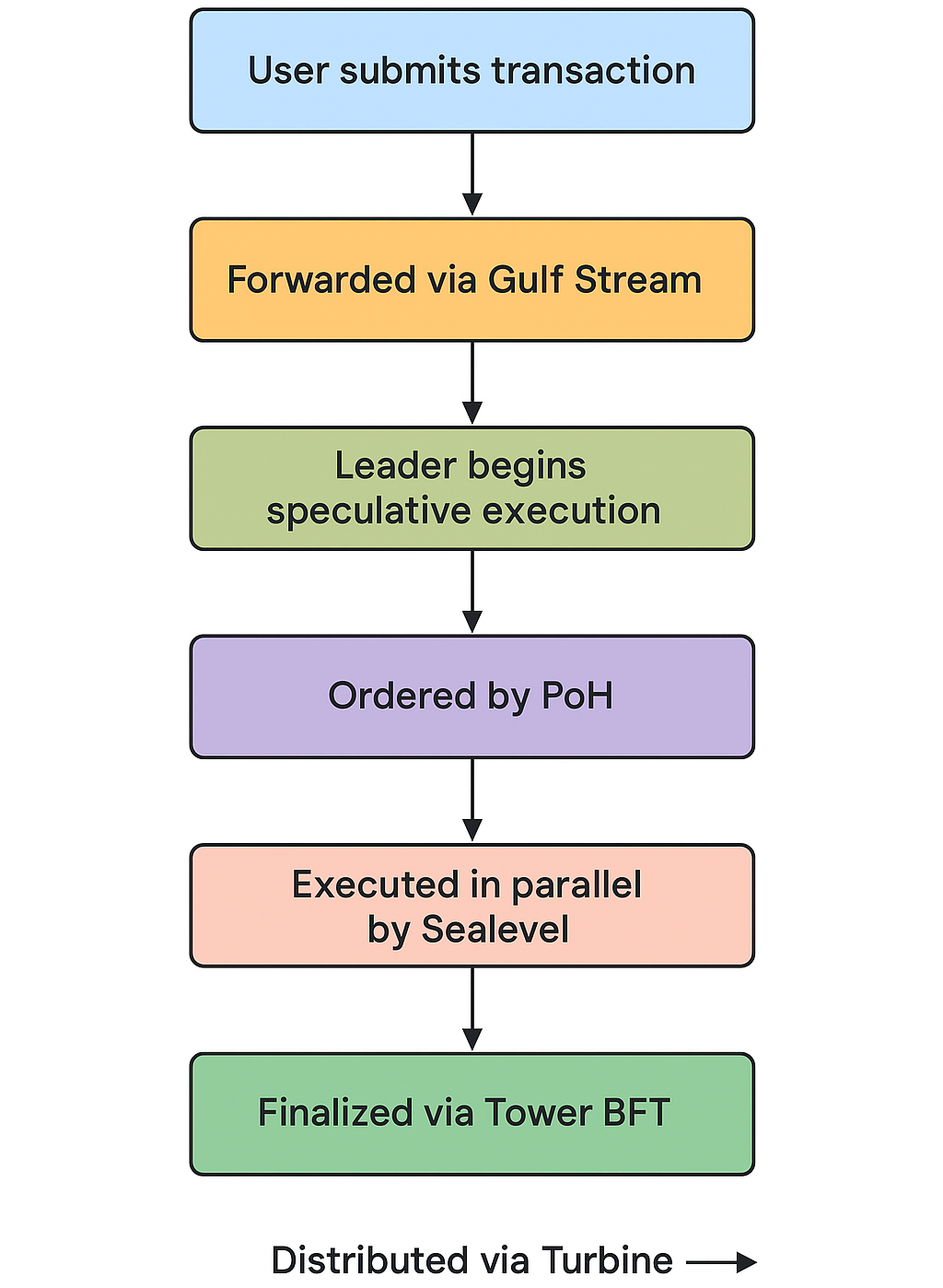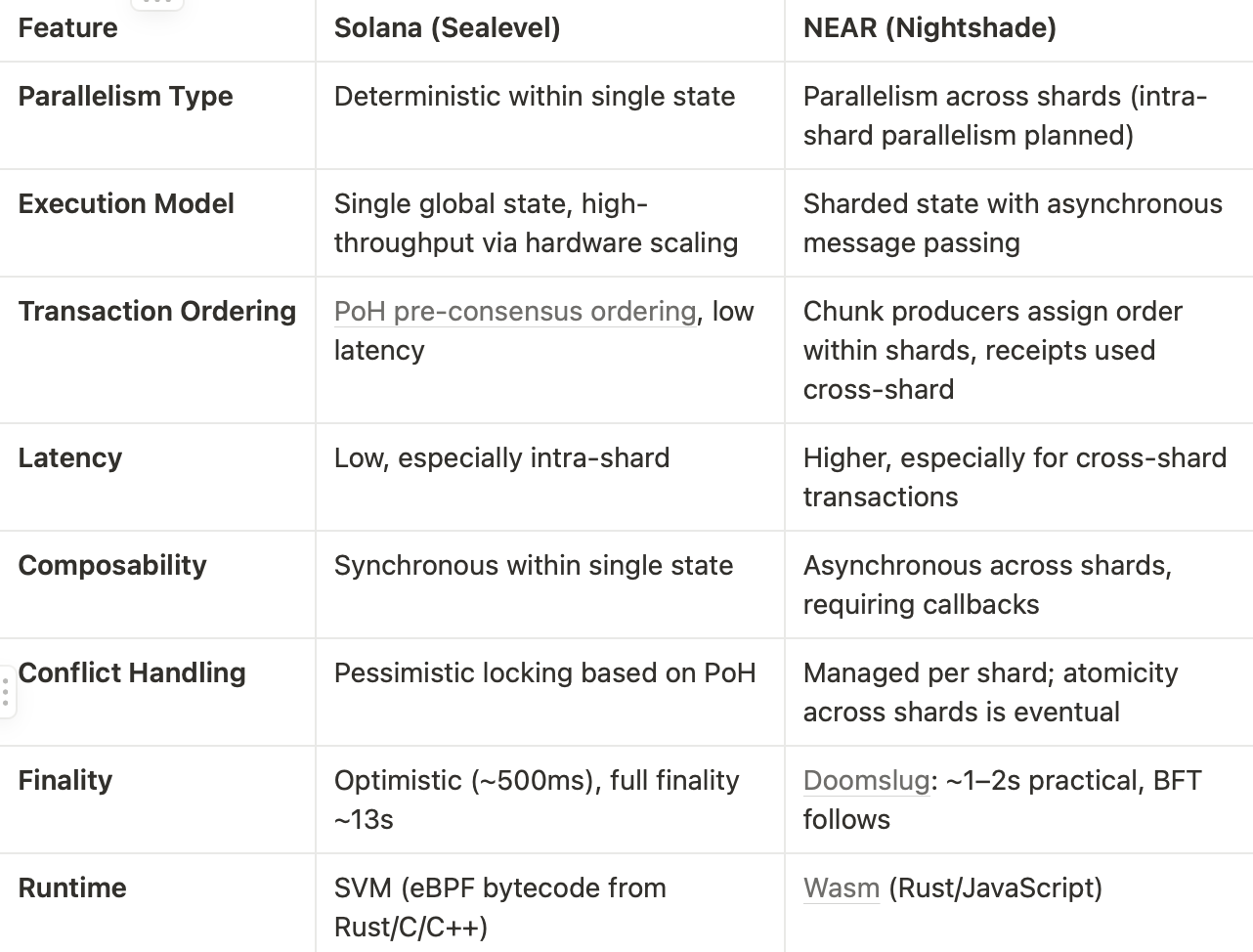Solana vs. NEAR Protocol: – Where Speed Meets Scale
A Technical Deep Dive into Execution Engine Architectures
In the dynamic realm of blockchain technology, the pursuit of a scalable and efficient Layer 1 network remains a central focus. The ability of a blockchain to process transactions rapidly and handle complex applications without performance degradation hinges critically on its execution engine – the core component responsible for scheduling and executing transactions. This engine room dictates the network's responsiveness, efficiency, and overall capacity.
Solana and NEAR Protocol emerged onto the scene around the same time in early 2020, both with the ambitious goal of overcoming the scalability limitations inherent in earlier blockchain designs. While they share this common objective, their architectural approaches to achieving high performance diverge significantly, particularly in how they manage the intricate process of transaction scheduling and execution.
Solana has adopted a highly integrated, monolithic architecture, often drawing comparisons to a finely tuned racing car. Its design emphasizes maximizing performance through a suite of unique innovations, most notably Proof of History (PoH) and the Sealevel parallel runtime, aiming for exceptional speed and low latency on a single, unified state machine. This approach represents a focused effort on optimizing the engine itself for peak velocity.
In contrast, NEAR Protocol employs a "divide and conquer" strategy through its Nightshade sharding mechanism. By partitioning the network's state and computational workload across multiple parallel chains or shards, NEAR aims for horizontal scalability, where the overall capacity of the network increases as more shards are added. This strategy focuses on building more lanes to handle increased traffic.
This report delves into the technical intricacies of the execution engines of Solana and NEAR Protocol, dissecting how each platform schedules and executes transactions. By examining the core architectural choices and innovative mechanisms employed by each, this analysis aims to provide a comprehensive understanding of their respective strengths and trade-offs in the ongoing quest for blockchain scalability.

Deconstructing Solana's Speed Machine: An In-Depth Look at Its Execution Engine
Solana's fundamental design philosophy revolves around achieving maximum performance by meticulously optimizing every aspect of its architecture, with a strong emphasis on leveraging advancements in hardware. Unlike many other blockchains, Solana operates on a single, global ledger, engineered for high throughput and minimal latency without primarily relying on Layer 2 solutions or sharding for its core scaling capabilities. This pursuit of speed is driven by a synergistic combination of several key technological innovations. These include Proof of History, which acts as a verifiable cryptographic clock providing order to transactions before they reach consensus; Tower BFT, a consensus mechanism optimized for PoH that enables rapid agreement among validators; Turbine, a block propagation protocol inspired by BitTorrent designed for efficient data dissemination across the network; Gulf Stream, a mempool-less transaction forwarding protocol that significantly reduces latency; and Sealevel, a parallel smart contract runtime capable of executing thousands of transactions concurrently.
While each of these components plays a vital role, PoH, Gulf Stream, and Sealevel form the core trifecta that defines Solana's unique approach to scheduling and executing transactions at remarkable speeds.

Proof of History (PoH): The Cryptographic Clock Ordering Transactions Before Consensus
Proof of History stands out as Solana's most distinctive innovation, serving as a crucial ingredient that significantly enhances the efficiency of its consensus mechanism rather than being a consensus mechanism itself. It functions as a highly efficient and trustless timekeeper for the entire network. Traditional blockchains often expend considerable resources on agreeing not just on what transactions occurred, but also on the precise order and timing of these events relative to one another. PoH elegantly circumvents much of this temporal negotiation.
At its core, PoH employs a high-frequency Verifiable Delay Function (VDF). Solana's implementation of this VDF utilizes the SHA-256 hash function, executed sequentially in a loop where the output of one hash becomes the input for the next. Given the inherent unpredictability of SHA-256's output without actual computation, and the fact that running these hashes sequentially consumes real, measurable time even on advanced hardware, the resulting chain of hashes acts as an auditable record of the passage of time. Each hash output in this sequence represents a "tick" on this cryptographic clock.
Validators on the network continuously generate these ticks. When a transaction arrives, it is timestamped by being incorporated into the PoH sequence at a specific tick count. This process embeds the transaction, or its hash, into the historical record, cryptographically proving that it occurred between two specific ticks.
This mechanism offers several critical advantages for transaction execution:
PoH establishes a canonical and verifiable order for transactions even before they reach the consensus stage.
Validators can trust the embedded PoH sequence, dramatically reducing the amount of communication needed to agree on the chronological order of events.
PoH significantly reduces the time required to confirm blocks and achieve finality.
Knowing the precise order of transactions upfront is the key that unlocks Sealevel's ability to identify and execute non-conflicting transactions in parallel.
In essence, PoH acts as a global, trustless metronome, synchronizing the network and paving the way for Solana's high-speed transaction processing pipeline.
Gulf Stream: Streamlining Transaction Flow for Minimal Latency
Solana's method for guiding transactions from users to the validators responsible for producing blocks, known as "leaders," is highly optimized, primarily through the Gulf Stream protocol, which facilitates mempool-less transaction forwarding. In many traditional blockchains, transactions reside in a public mempool, a waiting area where they compete for inclusion in a block based on fees. This introduces unpredictability and creates opportunities for MEV strategies like front-running.
Solana largely eliminates this public waiting room. A user signs a transaction, which includes account details, execution instructions, and a recent blockhash, and sends it via an RPC node. Rather than broadcasting the transaction broadly, the RPC node forwards it directly to the current leader and upcoming scheduled leaders.
Solana’s validator schedule is determined by stake weight and set for epochs (2–3 days). Leaders can begin speculatively executing transactions even before their slot begins. When it's their turn, they finalize execution, order transactions by PoH, and create a block.
That block is broken into shreds and distributed via the Turbine protocol, which uses a tree-like relay to disseminate data efficiently. Validators reconstruct the block, verify the PoH sequence, validate transactions, and vote using Tower BFT.
To reduce spam, Solana uses QUIC, a UDP-based transport protocol, and prioritizes forwarding from staked validators. The absence of a global mempool reduces latency and mitigates MEV risks.
Working in concert with PoH and a predictable leader schedule, Gulf Stream ensures fast, direct transaction routing, accelerating Solana’s transaction pipeline compared to traditional systems.
Sealevel Parallel Runtime: Unleashing Concurrent Transaction Processing
The culmination of Solana’s speed-centric design is Sealevel, its parallel smart contract runtime. While most blockchains process transactions sequentially to avoid state conflicts, Sealevel allows thousands of non-conflicting transactions to execute simultaneously across multiple CPU cores.
Each transaction in Solana must explicitly declare the accounts it will read from or write to — like listing dependencies before a task. Sealevel uses this to build a dependency graph, detecting conflicts and isolating independent transactions.
Transactions with no overlapping read-write or write-write accounts run in parallel.
Transactions that target the same account are executed sequentially, using pessimistic locking based on PoH order.
This strategy guarantees data consistency without needing complex rollbacks. Combined with Solana’s separation of programs (stateless logic) and data accounts (state), Sealevel achieves remarkable concurrency.
The result? Validators with powerful hardware can process hundreds of transactions concurrently, allowing Solana’s throughput to scale with hardware improvements — perfectly aligned with its performance-first philosophy.
NEAR Protocol's Horizontal Scaling Approach: Examining Its Execution Engine
NEAR Protocol tackles scalability using a fundamentally different design: horizontal scaling via Nightshade sharding. Instead of accelerating a single chain, NEAR divides the workload across multiple parallel shards. As more shards are added, the overall capacity of the network increases — like adding lanes to a highway.
Validators are randomly assigned to shards each epoch (12–14 hours), ensuring decentralization and minimizing the risk of collusion. Each validator produces "chunks" (fragmented blocks) related only to their assigned shard. These chunks are aggregated into full NEAR blocks.
NEAR started with one shard and scaled to four under Simple Nightshade. With Nightshade 2.0, dynamic resharding and stateless validation unlock performance improvements and increased validator accessibility.
A key advantage of this architecture is that validators only process data relevant to their assigned shards, reducing hardware requirements and increasing parallelism across the network.
Asynchronous Receipts: Coordinating Cross-Shard Transactions
NEAR manages cross-shard communication using a receipt-driven system. Here’s how it works:
A user submits a transaction targeting a receiver account.
The validator assigned to the sender's shard verifies it.
If valid, it generates one or more receipts to execute the requested actions.
These receipts are routed to the shard where the receiver account resides.
Validators in the receiver's shard process the receipts in future blocks.
Receipts can also spawn new receipts, enabling chained contract calls across shards. This model is inherently asynchronous, meaning interactions unfold over multiple blocks — unlike Solana’s synchronous execution.
NEAR avoids a global mempool. Transactions are routed to specific shard validator pools, while receipts are queued and executed within the destination shard’s local context.
Atomic execution across shards is complex. Although individual receipts are atomic, operations involving multiple shards only reach eventual atomicity. Developers are encouraged to handle partial state risks defensively. Research into cross-shard commit protocols is ongoing.
Wasm Runtime: Smart Contract Execution in NEAR
Each shard in NEAR runs a Wasm (WebAssembly) runtime environment. Developers use Rust or JavaScript to write smart contracts that compile into Wasm bytecode.
Within individual shards, execution is currently sequential — validators process transactions and receipts one after another. This limits intra-shard parallelism, though NEAR’s roadmap includes:
Parallel execution of receipts
Contract execution pipelining
Sharded contract functionality
These features aim to improve runtime efficiency and composability. While Wasm is highly portable and language-agnostic, it lacks built-in support for multi-threaded execution without custom extensions.
In summary, NEAR excels at distributing workload across the network (inter-shard parallelism) but lags Solana in concurrent processing within a single shard — a gap NEAR intends to close.
The Technical Showdown: Sealevel vs. Nightshade
Solana and NEAR Protocol represent two bold visions for scalable execution:
Solana is purpose-built for ultra-fast execution with integrated parallelism, while NEAR emphasizes modular scalability across shards. Solana’s design favors latency-sensitive apps like DeFi and gaming. NEAR provides smoother scaling for multi-tenant, high-volume environments where sharding makes sense.
Recent Advancements Shaping the Future of Execution
Solana’s Firedancer: A New Era of Performance?
Solana’s upcoming validator client, Firedancer, developed by Jump Crypto in C++, is poised to redefine Solana's throughput and reliability. With test benchmarks exceeding 1 million transactions per second, Firedancer introduces significant enhancements:
Modular architecture for independent upgrades
Optimized validator resource usage
Better decentralization through client diversity
An early version, Frankendancer, is already running on testnet, and Firedancer itself is live in a non-voting capacity on mainnet. Full mainnet deployment is expected in 2025. This upgrade not only increases performance but also improves network stability and staking rewards.
NEAR Protocol’s Nightshade 2.0: Boosting Efficiency and Decentralization
Launched in August 2024, Nightshade 2.0 introduced stateless validation to the NEAR ecosystem. Key features include:
Reduced validator hardware requirements
Increased live shards (from 4 to 6; aiming for 10 by end of 2024)
Enhanced decentralization and network capacity
Future improvements will focus on:
Optimizing state witnesses
Gas cost reductions
Dynamic resharding
Pipelined and parallel execution
This evolution furthers NEAR’s goal of frictionless horizontal scaling, making it easier for developers and validators to participate in the network.
Conclusion: Choosing the Right Engine for the Blockchain Metropolis
Solana and NEAR offer compelling, yet fundamentally different, visions for high-performance execution:
Solana is optimized for blazing-fast, synchronous execution in a single global state. It’s ideal for latency-critical applications like DeFi, trading platforms, and real-time games. PoH and Sealevel deliver unmatched parallelism — a design that thrives on high-performance hardware.
NEAR offers modular scalability through sharding, enabling efficient throughput growth by adding more validators. Nightshade’s asynchronous receipts and Wasm-based runtime provide flexibility and smoother onboarding for developers, at the cost of composability and latency.
The right engine depends on your application’s needs:
Choose Solana for atomicity, instant finality, and deep composability.
Choose NEAR for predictable scaling, ease of validation, and multi-shard capacity.
Both ecosystems are rapidly evolving, but in the current blockchain landscape, Solana’s Sealevel offers superior composability and execution speed.


